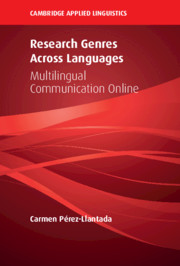Book contents
- Research Genres Across Languages
- The Cambridge Applied Linguistics Series
- Research Genres Across Languages
- Copyright page
- Dedication
- Contents
- Figures
- Tables
- Acknowledgements
- Abbreviations
- 1 Research Genres in Context
- 2 Theories and Metaphors
- 3 Science, Genres and Social Action
- 4 Language Diversity in Genred Activity
- 5 Genres and Multiliteracies
- 6 Innovation and Change in Genre-Based Pedagogies
- 7 The Way Ahead
- References
- Index
- References
References
Published online by Cambridge University Press: 24 June 2021
- Research Genres Across Languages
- The Cambridge Applied Linguistics Series
- Research Genres Across Languages
- Copyright page
- Dedication
- Contents
- Figures
- Tables
- Acknowledgements
- Abbreviations
- 1 Research Genres in Context
- 2 Theories and Metaphors
- 3 Science, Genres and Social Action
- 4 Language Diversity in Genred Activity
- 5 Genres and Multiliteracies
- 6 Innovation and Change in Genre-Based Pedagogies
- 7 The Way Ahead
- References
- Index
- References
Summary

- Type
- Chapter
- Information
- Research Genres Across LanguagesMultilingual Communication Online, pp. 215 - 243Publisher: Cambridge University PressPrint publication year: 2021

